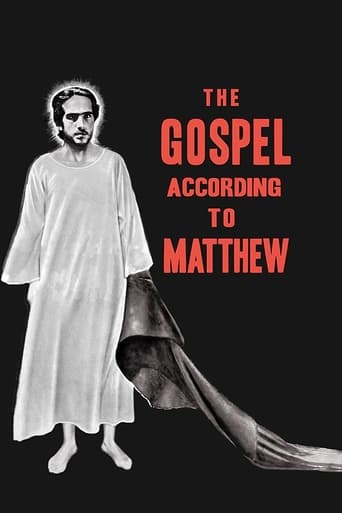Graybell
Rendering Bible stories into film is a difficult task, but Pasolini's account of Matthew's Gospel is among the most successful. The narration of events in the Bible is generally quite sparse, with only the most salient details given; as a result, events are fraught with hidden depths and profundity. Medieval art gives a similar effect, using completely different techniques. Filmmakers of the Bible generally attempt to flesh out the stories to make them more "real," but the result is inevitably banal and overwrought at the same time. Pasolini uses a different approach. First of all, he adds almost nothing to the text of Matthew's Gospel, and all the dialogue and events are directly from Matthew. Next, it's filmed in black & white, and the acting, especially Jesus, is consistently understated. Many quiet shots of faces watching, reacting, or, in the case of Jesus, talking. In these ways, Pasolini succeeds, to some degree, in reproducing the effect of depth and transcendence found in the Bible. The music (from Bach, Blind Willie Johnson, and others) adds considerably to the power of the movie.Pasolini's minimalist Jesus has an air of both humility and loftiness (as befitting one able to walk on water), but he is conspicuously lacking in emotion and expression. One might reply that Jesus (as God) doesn't share all our roller coaster emotions, but I see the New Testament Jesus as more of a Hamlet character, full of contradictory emotions. Pasolini's Jesus character's foreboding presentation could almost be seen as that of a young, conceited, dour, nihilistic Sophomore Philosophy student. A few quibbles: the Bible text describes large crowds of people following Jesus, but the movie only allows for a couple of dozen in most scenes. Also, in the movie, Jesus is often represented as preaching while he is walking, with his back turned away from his followers, who walk behind him. Finally, Mary the mother of Jesus is at most 20 when he is born, but she somehow becomes 70 years old during his ministry, when in fact she would have been only 50. With these reservations, then, I consider this the most successful Bible film I've seen.
adamshl
Pier Paolo Pasolini's Il vangelo secondo Matteo (1964) certainly is different from most other Passion presentations. The look of the film is rather rustic, as most is filmed in natural, outdoor, settings. The cities of Matera and Apuilia are supplemented by some sixteen other Italian locales, all highly artistic yet natural.There's an absence of elaborate costuming and period sets, with an often stark look giving at times a documentary feel to the proceedings. Pasolini's Christ, played by Enrique Iirazoqui, is quite level-headed in his orations and lacking in dramatics.The DVD I received is a "doctored up" 90 minute colorized version with dubbed English dialogue, which I feel doesn't do justice to the original work. However, the disc contains as one of its supplemental features, the black and white 137 minute film. The latter, I feel, is the film Pasolini made and the one to see.Since this writing a Blu Ray disc has been released (in 2012) with the 137 minute timing; I'm sure this is the preferred version to have.The music, from Bach to Odetta, is certainly one of the film's more intriguing aspects which supplements a most original rendering of this often filmed story.
dianewds-638-498121
Nearly 50 years later, this film still delivers in a big way! The characters translate both the spoken and unspoken Word; spirit is captured. Though many very slow and long shots, I found them purposeful and more of an addition than subtraction to the overall. The sets were realistic and the actors for Jesus, Mary and the Apostles were all believable. Even 47 years ago, the make up for lepers was really good. The technical for Jesus walking on the water was believable. Loved the scenes with Satan in the dessert and the sound and details with camera focused on the dust coming from his walk. Cannot think of a better modern day rendition of the NT.
billcr12
Here is a real oddity; a religious film directed by an atheist and Marxist, Pier Passolini. I share his non religious views, as a retired Catholic myself, but I can still appreciate the aesthetic beauty of the Sistine Chapel and other vestiges of the Roman church.St. Matthew, as the title implies, is based upon the writings of Matt. The black and white imagery, with long silent stretches, relies heavily on the actor's expressions, rather than dialogue. Many amateurs were used, including Passolini's mother as the Virgin Mary. Somehow, it works, as the cast is surprisingly good. Enrique Irazoqui plays Jesus as a wandering Jew, excuse the expression, roaming about and speaking a message of love to strangers he meets along the way. There is no preaching or piety, just a simple story of a man spreading the word of tolerance and salvation. The cinematography is somber and I was impressed by the simple and straightforward approach that Passolini used in creating this often overdone biblical story.


